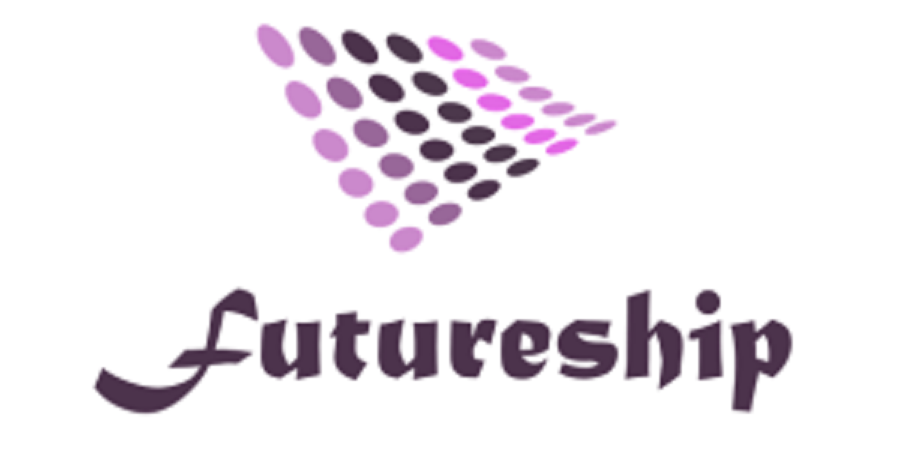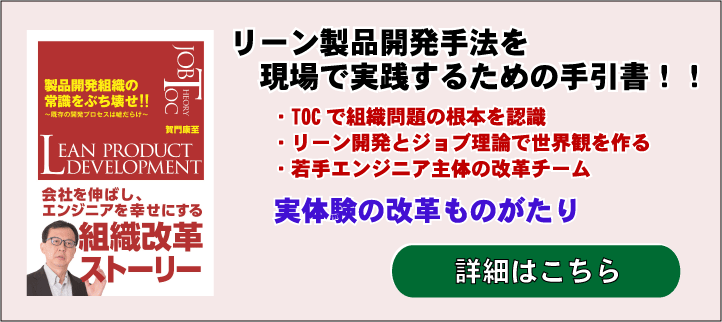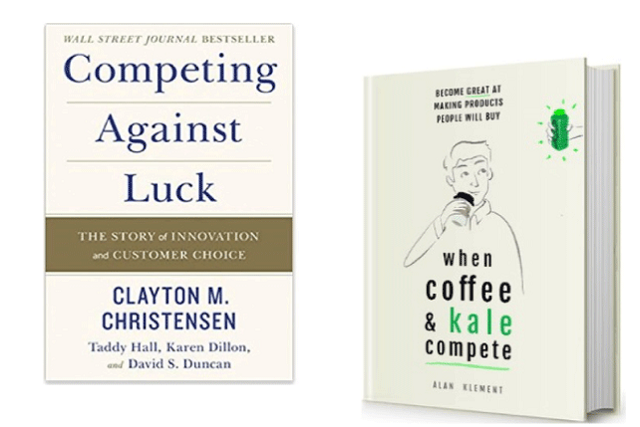

I understand the concept of Job Theory, but how do I put it into practice?
Job Theory is getting a lot of attention as a new way of thinking about marketing. I understand the concept by reading Christensen’s “Job Theory (Jobs to be done)” and understanding the case studies, but I would like to know if there is some kind of framework on how to actually implement it in my company
Based on my experience of realizing organizational reforms in many manufacturing companies with my original development innovation method that combines Toyota-style lean development and job theory, I have developed and implemented my own framework for creating businesses from job theory, and I will give you an overview.
It is a method of separating the head from the product, capturing the customer’s behavior in a story, and creating new customer value from the concept of the job that the customer should be doing.
I hope you will apply this method to product development or new business development at your company
Contents of this article
What is Job Theory?
The original title of Harvard Business School Professor Christensen’s “Job Theory” was “Competing against luck,” meaning that most innovation is the result of luck, and Job Theory is proposed as a methodology for breaking free from luck.
I believe that Job Theory is a new way of thinking about marketing.
Although it is not discussed in this article, I see it as having some ideas in common with Philip Kotler’s Marketing 3.0.(separate article “Here are some books to help you learn marketing in an easy-to-understand way” reference)
To put it very succinctly, I would say that Job Theory is a way to shift from thinking about product development from a product-based mindset to a 100% customer-based mindset.
From a different angle, job theory could also be a way to find potential customer needs. (Reference article: “How to find latent needs in product planning and product development”)
In continuous product development in a company, engineers tend to think of products in terms of products.
Even though the words “customer thinking” and “customer-driven” are often used and customer focus is advocated, the reality is that it is hard to change the ingrained thinking, and most of the ideas end up being product improvements and enhancements rather than coming up with what the customer really wants
Even though we are thinking about our customers, we never stop thinking about our products, and so we tend to think in terms of products.
Job theory is a method that corrects this habit of thinking of innovation in terms of the product itself, and helps us discover what customers really want, in other words, what their latent needs are.
In one of his lectures and books, Christensen introduces the essence of Job Theory in his story about the promotion of milkshakes at an American fast food restaurant.
It’s a famous story, so many of you may know it, but this story alone may almost explain what Job Theory is. (Chapter 1 of “Job Theory,” p. 30, is titled “Milkshake in the Morning.”)
This is a vague way of looking at it, but actually, this vague way of thinking could be called job theory
Customers do not buy products based on the products themselves, but rather they “hire” products to solve their unfinished “jobs” (errands, work).
The term “job theory” was coined when Christensen’s book was translated into Japanese, and the theory is said to have been originally conceived by Anthony Ulwick, who also called it Jobs to be done, or JTBD, or Jobs Method for short.
Ulwick’s JTBD method, which will be discussed later, has a solid framework and breaks down the situation where a customer uses a product into detailed job steps, like a story. Because it is a framework that uses outcomes for jobs, it is also called outcome-driven innovation.
On the other hand, as you may have noticed if you have read Christensen’s book, Christensen’s Job Theory does not provide a framework.
Reading through a lot of case studies is the way to understand and utilize the essence of this theory, but it is also true that it feels fluffy.
In addition to Ulwick and Christensen, Alan Clement’s “When Coffee & Kale Compete” is another book on job theory, but it is in the same family as Christensen’s and does not have a framework.
To distinguish between the two job theories, we call Ulwick’s method JTBD-P (Jobs to be done-product, also known as outcome-driven innovation) and Christensen and Clement’s theory JTBD-B (Jobs to be done-business).
Reference Articles:
What is Job Theory – A simple explanation of how to put it into practice
****I’ll give you the idea of job theory in terms that are a little easier to understand than the framework***
Using the two types of Job Theory
Existing product improvement vs. new business creation
….JTBD-P………..JTBD-B

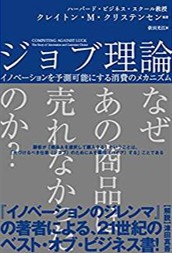
A Review of Jobs in Job Theory
In order to understand job theory, we must first understand what a “job” is.
A job is a task that a customer has to be done, and a job is basically anything that you have to do, or want to do, even if you are not aware of using the product.
A job is not ‘to do the laundry in the washing machine’ but ‘to clean the clothes’.
‘Washing machine’ would be a solution, so we don’t think of solutions, we see it as basically what we should do.
In the same way, ‘listening to a music CD’ becomes a job in job theory because a music CD becomes a solution.
Jobs are universal, and have been basically unchanged since the beginning of time.
Jobs do not change, but solutions change with time.
For example, for the job of “listening to music outside,” 50 years ago there was the portable radio solution, 30 years ago there was the Walkman solution, and now smartphones are the mainstream solution.
For the job of “storing data,” floppy disks were the solution in the past, then USB memory devices became the mainstream solution, and now cloud storage is the new solution.

The more accurately we understand jobs, the easier it is to see the path of innovation.
In addition, there is the idea of emotional jobs, and Christensen’s job theory specifically uses the idea of ‘progress’ to view human desire as a job.
This area may make it difficult to understand jobs, but you can think of jobs as being of several types.
For example, “I want to be a good father. or “I want to be recognized by others. etc. are also considered jobs in a larger sense.
In this way, we can understand the human desire for evolution, including both manifest and latent desires.
The concept of jobs will become clearer as we study innovation cases that utilize job theory.
Types of Jobs
Jobs may be difficult to understand because there are several types of jobs, and the sense of capturing them is completely different.
Jobs can be categorized as follows.
- Functional Jobs
Exactly the functions that customers have to do in their daily lives. - Social Jobs
Social status, asserting oneself in a group, asserting oneself - Emotional jobs
Safety and security, beauty, self-realization
Functional jobs are easier to understand if we think of them in terms of a product, the procedures for using the product, and a series of movements such as preparing, setting up, executing, monitoring the progress, finishing, and cleaning up.
In addition, since jobs essentially exist regardless of the product or anything else, we can discover them by taking our minds off the product and thinking about the essence of the customer’s behavior, what they originally want to do.
It is easy to understand if you think of it as a series of actions such as checking what ingredients are left at home, thinking about the menu for today’s dinner, thinking about the necessary shopping, shopping, putting the items you brought home into storage, retrieving the necessary items from the food storage, and preparing the food.
Such a series of necessary jobs can be considered as subordinate jobs.
On the other hand, we consider social and emotional jobs to be higher level jobs.
Self-actualization jobs, such as a woman wanting to be beautiful, designing herself to look beautiful or attractive, or wanting to be seen as rich or a good boss, can motivate customers to change and adopt new things (or products, as the case may be).
Also, wanting to spend more time with family and less time doing housework is an evolutionary desire that requires change in society somewhere in the mind, which is also treated as a job in job theory.
Many of the higher-level jobs, such as the desire for self-actualization and the desire for evolution, do not have solutions at the moment, but these jobs (higher-level jobs) are treated separately from functional jobs (lower-level jobs).
A Framework for Putting Job Theory into Practice
Since the latter half of 2016 (before Job Theory was published in Japan), we have been studying several JTBD methods developed in the U.S. and working with our clients to create a cut-and-try framework for Job Theory.
Originally, I did not disclose the details of the JTBD method to anyone other than my clients, but I thought I would share the outline of the JTBD method here so that it can be widely used.。
JTBD-P (Outcome Driven Innovation) Framework
Ulwick’s JTBD method (JTBD-P, where P is for Product) is also known as Outcomes Driven Innovation.
The main difference from Christensen’s and Klement’s theories is that Ulwick’s method is a job theory with an existing product in mind.
So in this method, the first step is to view functional jobs as a series of actions with product functions in mind.
As a guideline for finding jobs, a kind of hint for finding jobs is provided, as shown in the figure below.

For example, when you think about a product called an electric saw used by carpenters
Define → Decide what to cut and for what purpose
Find it → Bring it from the storage place to the work place
Prepare → Turn on the power, set up the wood, and ink it
The first step is to pick up the job from a series of customer actions, using the keywords written in the clue circle as clues.
In the case of an electric saw, let’s pick up the job as a series of steps. (This is just an example)
- Carry the saw from the storage area to the workshop
- Set and fix the wood
- Turn on the saw
- Set the angle of the blade
- Marking the cut line
- Cut along the line
- Watch for any deviation from the line
- Correct any deviations
- Carrying the cut lumber
- Clean up chips
- Cleaning up the saw
Next, for each job, extract the customer’s outcome expectation (outcome) for the job
In the example of the electric saw, the outcome for the job of cutting the material along the line marked by the saw is to minimize the gap between the marked line and the cutting position as much as possible.
Outcome is a game of ideas from the customer’s perspective, something like the hint for finding jobs is provided as shown in the figure below.
List as many things as possible that the customer might care about, but be careful not to make any assumptions.
As a result, here are some examples of outcomes that actually got a lot of customer attention with electric saws
- Minimizing the amount of sawdust blowing in the operator’s face as much as possible
- Reduce the amount of sawdust hiding and displacing the cutting line
- Reduce the time required to set the blade angle.
- Reduce repair time when the power cord is cut or damaged.
- Reduce the chance of a fall when lowering from a ladder or roof.
Thinking apart from electric saws, suppose we have a job, for example, to “listen to music when we go out”
The outcome for this job could be something like this
- Spend as little time as possible downloading music that suits your mood when you go out.
- Spend as little time as possible selecting the music you want to listen to while operating the machine
When you go out・・・Situation description
Downloading music that suits your mood・・・Management target
Time・・・Unit of measurement
Make it as short as possible・・・Direction
The customer’s expected result (outcome) for each job is written in the form of
In the JTBD-P method, we define about 100 outcomes for a product, and for each outcome, we interview and score the current situation for the customer.
In the JTBD-P method, the customer’s expected result (outcome) is written for each job.
In other words, the importance and sufficiency of the current situation and for each outcome are heard in the score.
Scores are taken from as many customers as possible, and opportunity scores are defined as importance 1-10 (10 being the highest score) and sufficiency 1-10 (10 being the highest score).
Opportunity score = importance - max (importance – sufficiency, 0)
The JTBD-P framework is based on the idea that those with a high opportunity score are considered to be opportunities for innovation, and that we should concentrate on outcomes with high opportunity scores to consider ideas.
The essence of the JTBD-P framework is to intuitively look for outcomes with high importance and low sufficiency, rather than severely assigning opportunity scores.
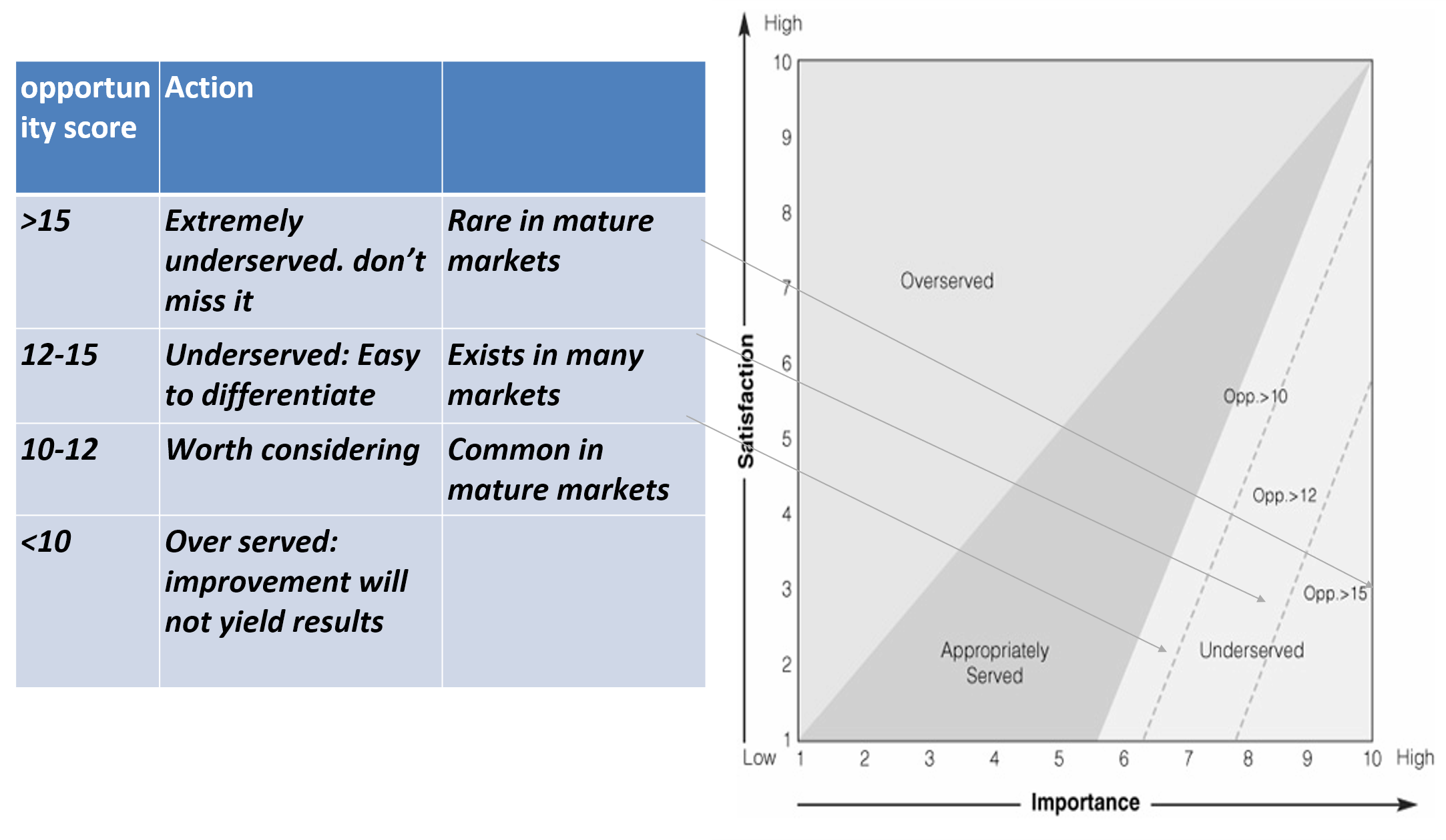
In 2001, Bosch entered the North American market with an electric saw. The company used Job Theory (JTBD-P) to brainstorm 14 items with high opportunity scores, and was able to successfully enter the North American market with a highly competitive product by incorporating low-cost ideas into the product.
This method is relatively easy to implement because the framework is clear, and it is especially effective when there is a strong demand to improve existing products without cost.
The key to this method is the ability to come up with ideas that will lead to unexpected discoveries while ensuring that the outcomes are not omitted, and the need to obtain feedback from customers through the relationship with them.
Comments:
You can experience and learn how to use the JTBD-P framework in about 2 hours of exercises. We can provide an exercise program for your company or organization, please contact us for more details.
JTBD-B (Christensen’s Job Theory) framework
JTBD-P originally has the above framework defined, but Christensen’s Job Theory does not have a clear framework
In our company, we have created a framework for JTBD-B (B for Business) based on the ideas of Christensen and Alan Klement’s Job Theory, assuming that we are going to innovate or create new businesses in practice. This is our original framework.
To put it simply, first of all, similar to what we use in Ulwick’s JTBD method, we define a customer’s job as a series of detailed jobs like a story.
I will illustrate an example of business development by JTBD-B using a low-end 3D printer for consumers.
The objective is to look at the entire low-end 3D printer business and think of new businesses and new products.
The figure below is an example of job steps for a customer who is thinking of purchasing a low-end 3D printer. It continues as follows: “I want to make something,” “I get a 3D printer,” “I learn how to use it,” “I create 3D data,” and so on.
Ulwick defined the outcome for each job, but in our framework, we will list the solutions that exist in the world for each job.
The story of the job and all the solutions for that job are mapped out. (Figure below)
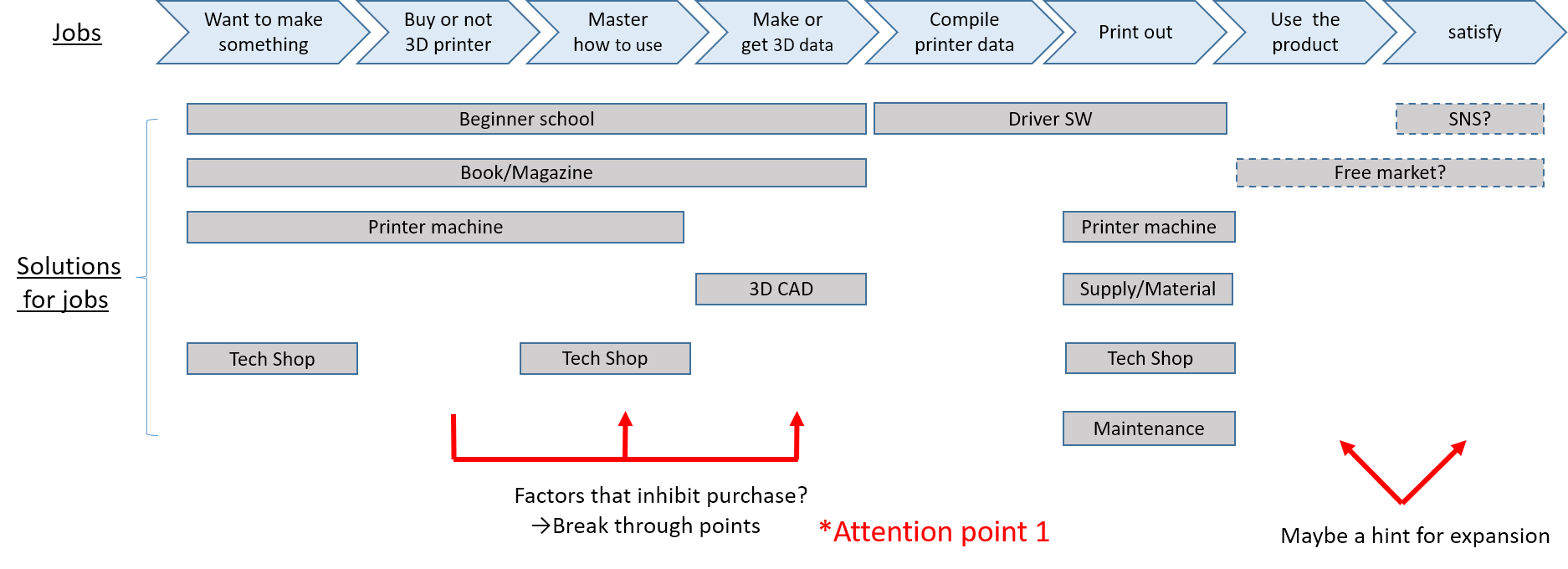
Attention!
In JTBD-B, the trick is to think of jobs independently of the product, but in the above example, the job is based on the 3D print
When you want to come up with an alternative solution to the 3D printer, it is important to remove the 3D printer from your mind, but since the task this time is to think of a new business by grasping the whole picture related to the 3D printer, we extracted jobs with the 3D printer in mind.
In this way, the job theory effectively advances the achievement of goals by flexibly changing the granularity of jobs according to the purpose.
While using this solution map, we can see various things. We made this map considering the 3D printer business, but each solution on this map is an independent business.
On this map, each solution is an independent business. And multiple solutions can be competitors in some cases, and conversely, areas with thin solutions can be blue oceans.
More importantly, when we follow the story of a job from the customer’s point of view, we can discover the factors that make it difficult for the customer to buy the 3D printer itself unless the solution for a certain job is weak for the customer, or rather, a stronger solution, i.e., the customer is not able to shorten the distance to the entire business.
Furthermore, from this solution map, as shown in the figure below, we can understand the business structure of this industry and find out the points where we should collaborate, compete, strengthen, and enter.
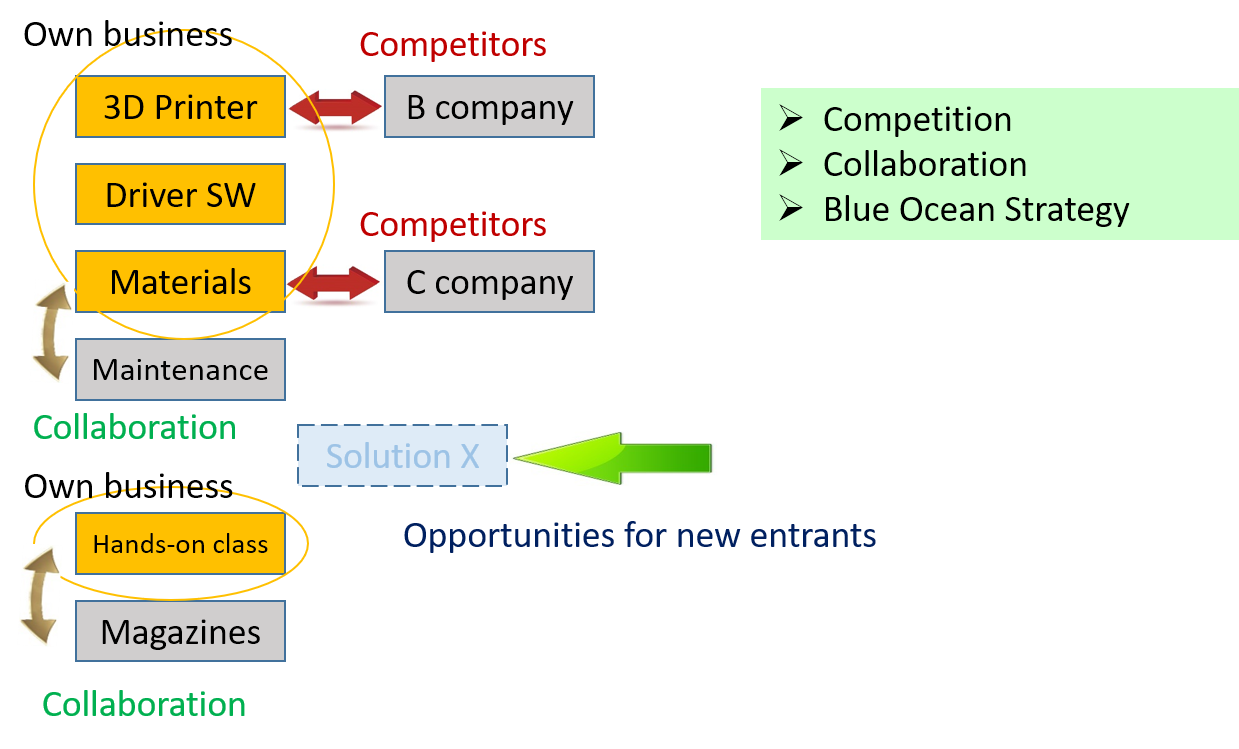
We have been conducting an exercise to think of new businesses and products in the 3D printer business using this method at our seminars, and I would like to introduce some of the ideas that come up.
The first idea is to offer a new solution that is easy to introduce to potential customers who are not willing to take the first step to try it out because it seems difficult to use or they don’t know what to make. The idea is to introduce the Diagostini model (which some companies have actually successfully implemented), where the customer is able to assemble a single 3D printer, and in the meantime, get information on how to use it and what can be made with it, in order to gain customer satisfaction.
For the customer, it is a relief to know that they can quit the service if they get tired of it, and for the company providing the service, the drop rate can be read to some extent, so the risk of having excess inventory can be reduced.
The second idea is to provide a service that delivers 3D data to customers who have experienced making something once and want to continue using the 3D printer, considering their concerns such as the difficulty of thinking about what they want to make or the difficulty of creating 3D data in the first place.
There are services that distribute free 2D images, photos, and illustrations for web creation
This could be a freemium model with free membership for regular members and a premium membership with special service
The framework creates a situation where it is easy to come up with ideas that can be used in practice.
In addition, I believe that the probability of innovation can be increased by connecting this map with the higher-level jobs that exist inside the customer as a higher-level concept than the storytelling job steps mentioned above.
This may be difficult to understand, so let me explain the framework again from a different perspective.
In Christensen’s Job Theory, you will find the term “customer’s desire for evolution” (Progress in the original).
We call this a higher-level job in our company.
Kotler’s Marketing 3.0 advocates increasing corporate value and brand value by connecting the company’s value with the higher-level job, i.e., the customer’s desire to evolve. The Job Theory also advocates the value of connecting the company’s mission with the customer’s desire to evolve (the higher-level job).
The figure below shows the concept of the Job Theory framework that we propose.
It is an example of how we try to tell the story of a life of storing food (refrigerator, cupboard, etc.), cooking, and enjoying a meal using Job Theory.

Considering the customer’s desire to evolve, define the value of the company from the customer’s point of view that can be met, i.e., the value provided as a brand strategy.
While keeping the two higher-level concepts in mind, consider the lower-level jobs as steps or stories.
Map out the solutions that currently exist for each job step.
The general flow of the process is to put each solution side by side and gain deep insights into the concerns, habits, and problems with the solution to come up with ideas.
The process of creating a solution map, or discussing it in depth with several people, will reveal issues and holes in the business.
We can come up with ideas while self-checking whether the current solutions or the solutions we want to propose in the future meet the customer’s series of behaviors and higher-level jobs, in other words, the desire for evolution.
I encourage you to start by making a map.
This framework may be difficult to understand just from the text, unless you have a sense of the original theory and also have a good awareness of the product development process. I explain it in a little more detail in another article, 「“Open Innovation Using Job Theory to Capture the Business Ecosystem”」
If you would like to actually try it, understand it more thoroughly, and master it, please join the hands-on seminar at the bottom of the page. You will be able to deepen your understanding through exercises.
One of the features of the Job Theory framework that we propose is that it changes the thinking of the product axis by 180 degrees by considering jobs as customer stories.
There is no single story.
The diversity of customers is also advancing, and many ideas can be derived from multiple stories.
Specifically, we write down the customer’s job story, the current solution for each job (solution map), and then dig deeper into the idea of changing the solution by gaining insight into the four elements that control human desire: push, pull, habit and worry.
I think it is difficult to understand just by words.
You can learn how to use the business creation framework based on Job Theory (JTBD-B) in about 2 hours of exercises.
※ We can provide training programs for your company or organization. If you have any requests, please contact us using the inquiry form.
Job Theory Framework for Organizational Change
Have you ever thought about the ecosystem of your business?
The Job Theory (JTBD-B) framework that we have defined is strongly based on the idea of a business ecosystem.
With the diversity of the market and the rapid progress of IT systems, it is becoming impossible for a single product or a single company to compete alone.
Multiple solutions (combinations of products, services, infrastructure, etc.) are often the only way to satisfy customers.
There are still many companies in the manufacturing industry that have not yet caught up (understood but not acted upon) with this idea.
Our Job Theory framework allows us to look at the job story from the customer’s side and show them the ecosystem they need.
Taking an organization or individual that has been thinking entirely in terms of a single product, and looking at the entire business from the customer side, and seeing opportunities for collaboration and new entrants, is a huge step forward for the organization, and provides the thinking that can lead to significant differentiation from the competition.
Thinking about business ecosystems is also linked to the promotion of open innovation.
This means that large companies will be able to utilize venture companies, and companies will be able to effectively promote cooperation and collaboration among themselves.
(※ For more information on business ecosystems, you may want to refer to “Wide Lens” by Ron Adner)
What I would like you to try is to organize a small group of members to create a solution map → business map, so that you can get various insights from the business ecosystem and increase the probability of innovation from there.
Please refer to the following article, which introduces the flow of realizing open innovation that goes beyond the scope of your own company by capturing the business ecosystem and coming up with ideas using the framework proposed by our company.
Related articles:
 Customers will not be satisfied with a single business. Find an integrated solution from the customer’s perspective!!
Customers will not be satisfied with a single business. Find an integrated solution from the customer’s perspective!!Open innovation that uses job theory to capture the business ecosystem
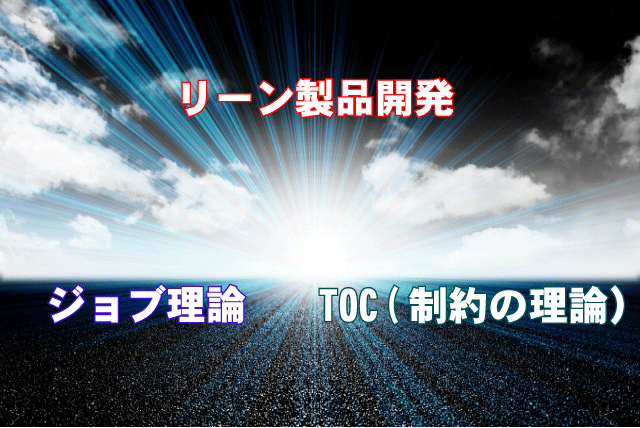 Reform strategies using Toyota’s development methods, latest marketing and problem solving frameworks!!
Reform strategies using Toyota’s development methods, latest marketing and problem solving frameworks!!Organizational reform strategy for product development using Lean development, Job Theory and TOC
Job Theory Framework hands-on seminar
We offer seminars where you can gain hands-on experience with the job theory framework we have developed.
This seminar is designed to strengthen your marketing thinking skills by reviewing product and business development from the customer’s perspective from a wide range of perspectives, including not only job theory, but also marketing evolution, ecosystems (business ecosystems and collaboration), and the application of design thinking.
Here, you will be able to practice the above framework by doing exercises using solution maps.
The significance of the job theory framework will be explained in detail
Seminar title
Job Theory and Marketing Thinking Seminar
Overview
- Limitations of Product Out, Evolution of Marketing
- Complete shift to customer-driven by job theory
- Customer observation and questioning skills to grasp true customer requirements
- Innovation Exercise with Solution Map
※ If you would like to attend the seminar as a whole organization or as a team instead of individually, please contact us through the inquiry form below.
